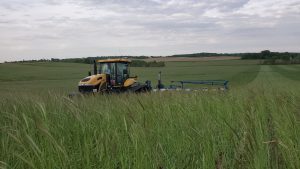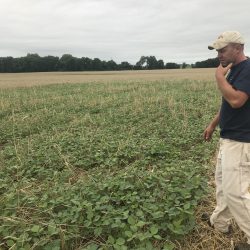 Planting into head-high cover crops wasn’t the plan, but making adjustments to improve soil health and the overall productivity of the farm is business as usual for Tama County farmer Adam Nechanicky.
Planting into head-high cover crops wasn’t the plan, but making adjustments to improve soil health and the overall productivity of the farm is business as usual for Tama County farmer Adam Nechanicky.
“The seed beans didn’t show up until early June. By then the rye was taller than the planter boxes and when I jumped off the tractor I was eye-to-eye with the top of the plants,” he said.

Two fields were separated by a lane, with one side being aerial seeded in September and the other drilled in November. “It was late November and I was drilling into frozen ground. It was interesting to see the side-by-side growth and development, but both fields obviously grew well,” he said. “It was a new experience; one challenge was not being able to visually confirm what’s going on with the planter, but it worked well. I burned it down after planting and the stand looks great.”
Cover crops are a foundational element in Nechanicky’s soil health approach. He sees value from weed control, soil retention, soil building and nutrient sequestering. He knows the ROI is not plainly obvious the first year. “Farmers need to look at cover crops as a long-term investment. You probably won’t plant a cover crop the first year, have it all go right and say you got X number of dollars back,” he said.
A visual clue for Nechanicky that his cover crops are working occurs after any heavy early-spring rain. He no longer sees cornstalks being pushed across his fields, plugging tiles and piling up in the ditches.

Nechanicky applies that same detail to the nutrient program. The last couple of years he switched from anhydrous to split applications of liquid nitrogen. “There are pros and cons to everything. I grew tired of hauling tanks around and working around NH3 gas. A split application is more ideal from a nutrient management standpoint,” he said. “But it was a benefit again this year because I didn’t lose nutrients in the area impacted by the creek flooding.”
Tama County is currently a garden spot for yield potential. In late July, Nechanicky expected yields to be a bit above his farm average.
As he prepares for harvest, he knows weather could throw a curveball, so he’s ready to adapt. “I try to get a cover crop on all my acres, but the timing between seed corn production, seed bean production and conventional harvest is really tight,” he said. “I have an air seeder and a drill, but I’m willing to fly the covers on if needed.”
When asked why he will continue using 4R Plus practices on his farm, he said, “It’s a process to uncover the benefits on your ground. You have to think about the value of your soils to you and your legacy, and you’ll see them work for you.”
Click here to ask Adam a question about his farming operation.
